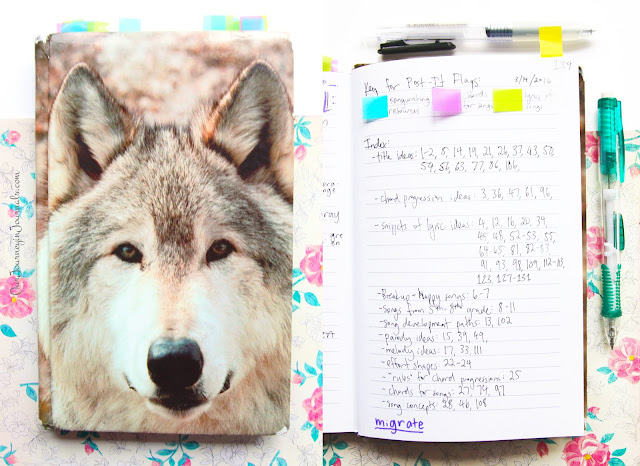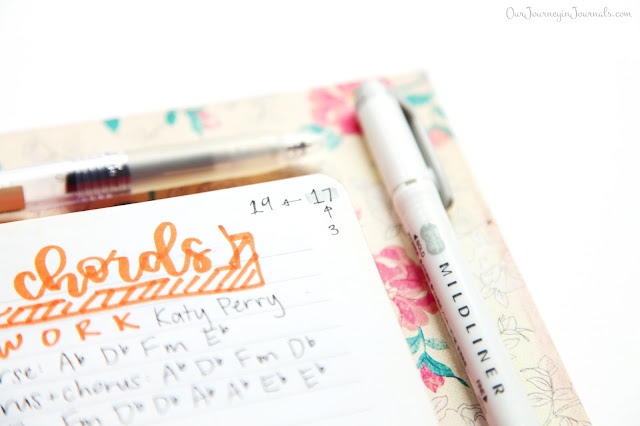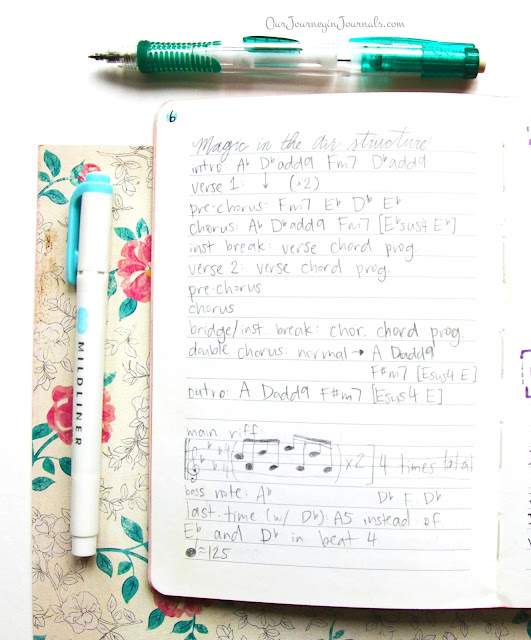I don't know how applicable this will be to you, but this is something that I'm personally quite passionate about. Along with calligraphy, my other "main" creative hobby is music making - especially songwriting. Ever since I started writing original music and getting more serious about music, I've kept a song journal. In it, I primarily have stuff about my own original songs, but I also use it as a resource for music-related things in general.
My first song journal, which I started a little over three years ago, was honestly a bit of a mess. However, because of my knowledge of the bullet journal system, I was able to apply parts of bullet journaling to the setup of my second one. In this post, I'm going to show you how to apply bujo techniques to your songwriting notebook if you're also a songwriter (specifically a singer-songwriter), but I'm also going to show in general how the bullet journal system can be adapted to not just your planner, but to other notebooks for creative hobbies and such--or really anything else that you need organization for. Read on!
What Notebook Should You Use?
 |
| My current song journal |
First of all, I'm going to discuss what specific type of notebook you should use. Of course, the criteria can vary widely from person to person, but here are the things that you should consider:
- Size: I wanted something small enough to fit in my ukulele case, but not something that was so small that it would be a hindrance
- Ruling: I 10/10 suggest using a lined notebook; this offers the best mix of structure and flexibility for a song journal (dot grid, like is often used for bullet journaling, would also work, but it's just harder to find notebooks with dot grid paper)
- Cover: your songwriting notebook should be something that makes you happy, so make sure to use something whose cover you like! Or, alternatively, you could decorate it yourself
- Page numbers: you don't necessarily need to get a notebook with pre-numbered pages (there aren't many journals out there like that anyway), but I highly recommend at least using one that has space to write out page numbers
- Hardcover: I strongly suggest a hardcover over a softcover notebook because the former is much more practical
Old vs. New (i.e. "Wow, I Like Bullet Journaling")
 |
| My old songwriting notebook |
Next, let me just show you my old song journal. There were a few flaws in my system, the major ones including:
- Dating entries was a huge hassle because sometimes I would work on things over the course of several days, and sometimes, I would be writing things in my notebook weeks after I first came up with the idea.
- The index was disorganized, so it took up too much space. In addition to this, I occasionally had difficulty finding what I needed.
- Overall, it was just messy and not great to look at.
After I finally finished it after about two and a half years, I set up my new songwriting notebook. I started out with a table of contents in the first two pages--which might be not enough, though it may be a possibility that I'll need to set up a third page. Inspired by my bullet journal, I no longer index/ log in my table of contents every single spread and collection, which is what I used to do. This leads me to the biggest single change in my song journal system: my color code!
For this, I got the idea from Boho Berry's color index from a while ago that she used to implement in her bullet journal (hack 1 in this blog post). What I do is highlight the page number using designated Zebra Mildliners based on what sort of collection it is. This helps to both free up space in my table of contents and organize my songwriting notebook more effectively and at a glance.
Another thing I do in my song journal that I stole from bullet journaling is page threading. Page threading is where you write the page number of the previous or next page of related spreads. For example, I use this is in my "song chords" layouts, since I don't index those. The highlighted number in the corner (17) is the actual page's number, the number with the arrow pointing to it is the page of the previous song chords collection (3), and the number that 17 is pointing to (19) is the page of the next song chords spread. This helps me organize my song journal better so that even though I "declutter" my table of contents by not including many types of spreads in it, I can still find them fairly easily.
Lastly, because of my experience in using a bullet journal, I'm just overall better at making both effective and aesthetically-pleasing layouts. This is how I set up some specific spreads:
Original Songs
 |
| This was the layout for my song "Magic in the Air" |
Though this is a general song journal, it is primarily a songwriting notebook. So, of course, the spreads for my original songs are the most important. I complete the song in a separate large, cheap notepad so that I can just scribble out ideas and not be afraid of formatting or "perfecting" anything. After I'm satisfied with the song's completion, I make its spread in my songwriting notebook. Each original song layout consists of the following:
- A hand-lettered header that somehow goes with the song (in terms of color, overall aesthetic, etc.) + the time frame in which I wrote the song
- Lyrics (including chords for each section of the lyrics)
- Song structure: this shows, in a very clear-cut manner, the chord progression for each section of the song--including instrumental breaks--and how many times they're repeated (I like using this "song structure" for reference and to minimize page turns for live performances and recording sessions)
- Extra information like tempo, tabs, etc.
Also, even though I have a fairly good musical memory, I always ensure to record a demo of the song either on my phone or my laptop; as a songwriter, never, ever trust yourself to remember the things you come up with.
I have a separate spread where I list and number all of my original songs, when they were written, and what page number they're on.
Song Inspiration and Ideas
I have several spreads to record random ideas I have, including for song titles, snippets of lyrics, chord progressions, and song topic/metaphor ideas. These are simply listed out--nothing fancy. Writing all of these things down is super useful because like I said before, you can never be certain of remembering your ideas.
Not Original Songs
I occasionally make spreads of songs I like to cover that include a song's lyrics and chords written above (sort of like something you would see on Ultimate Guitar), but I typically forego the lyrics and simply write the chord progressions and which sections of the song they correspond to--like in the above picture. I even don't bother with writing out the song's structure (i.e. when each verse and chorus is and such), since if I have the lyrics memorized, then that would be unnecessary. I mostly keep these for reference for performances.
Resources, Techniques, etc.
Just like with a bullet journal, I really make any spread that I feel necessary and want to have down on paper and right in front of me. As of right now, I have spreads dedicated to common transposing instruments (i.e. a list of the dumb instruments that don't read sheet music in concert pitch), ideas for song structures, effort shapes (information on types of melodic textures I stole from Music Composition for Dummies), the different modes, the modulation effects on my Fender Mustang amp, a record of the different signatures I have on one of my ukuleles, and common out of key chords.
Obviously, this is a large hodgepodge of collections--again, literally just whatever I need. Also, because these are all "one-off" collections, I actually index these ones--unlike the song inspiration and "not original song" spreads.
If you're a current or aspiring songwriter, I hope this post was helpful for you in learning how to set up a song journal/songwriting notebook! If you don't fit into this category, I hope that I at least demonstrated how you can take things from bullet journaling and apply them to other types of journaling. If you have any questions, feel free to either email me or leave a comment!












No comments:
Post a Comment